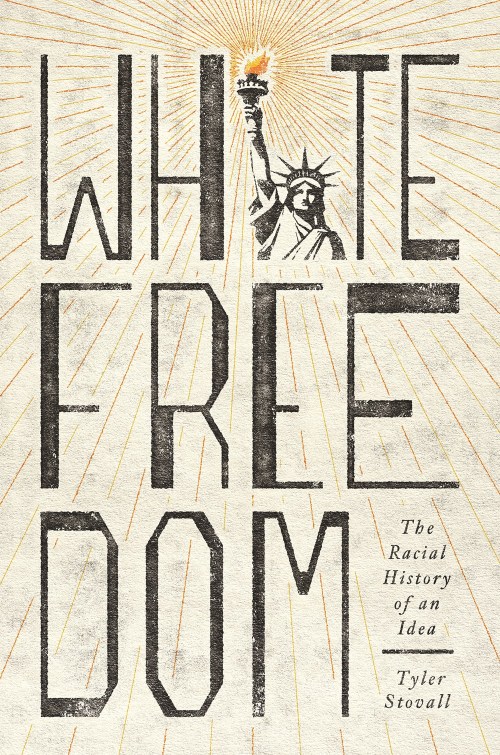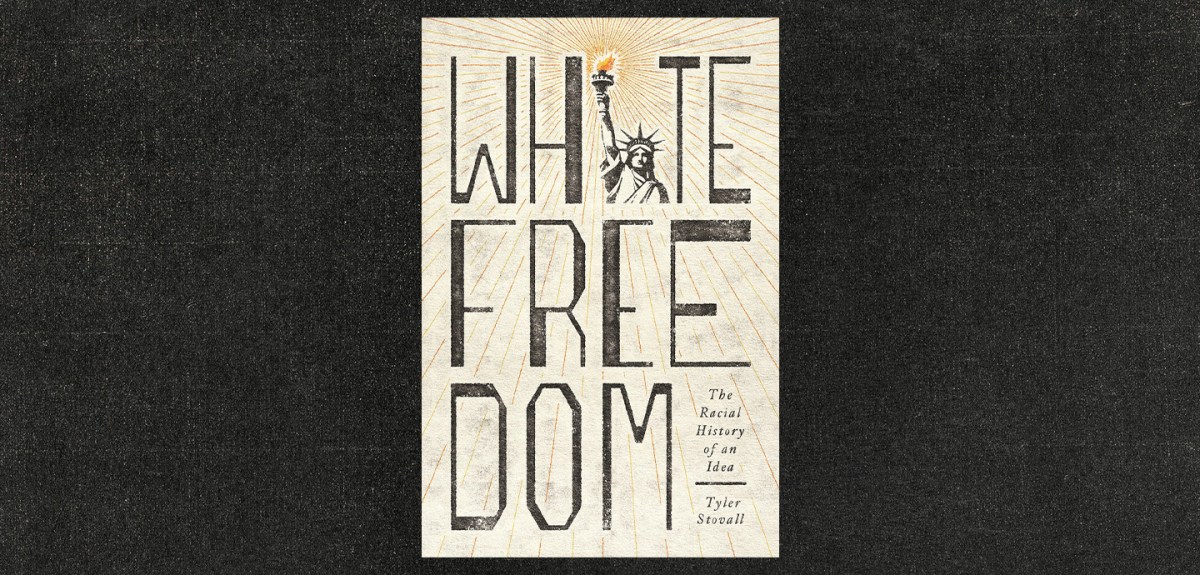[ad_1]
Editor’s Note: This book and this review were written before the insurrection against the United States Capitol on January 6th, 2021
1.
Two events in recent history:
In April and May of 2020, a series of demonstrations took place inside and around the state Capitol in Lansing, Michigan. Demonstrators gathered in protest of recent stay-at-home orders by Governor Gretchen Whitmer intended to help slow the spread of the coronavirus. The orders closed theaters, bars, gyms, and salons. It limited restaurants to carry out. The crowd was largely white and more than a few were armed — a number of protestors carried assault rifles slung across their chests. Outside the Capitol, protestors carried signs that read “Give Me Govt. Distancing,” and “Tyrants Get The Rope.” Inside, demonstrators tried to force their way into the legislative chamber chanting “Our house,” and “Let us in.” These chants were made in the face and against the bodies of the Michigan State Police who, without reverting to force, kept the protestors at bay. One group, Michigan United for Liberty, called the moment “judgment day.”
Starting two weeks after the demonstrations in Michigan and running throughout the summer, a series of protests under the banner Black Lives Matter happened across the country. The first of these in Minneapolis, Minnesota in response to the murder of George Floyd at the hands, or knee, of the Minneapolis Police Department. The protests against racism, police brutality, and for racial justice, spread from city to city as organizers rallied and communities took up the BLM mantle. While these protests were, for the most part, peaceful, some rioting and destruction of property did occur (although by whom and to what extent local and federal forces of authority instigated and provoked demonstrators is an ongoing discussion). Unlike the protests in Michigan, where police provided passive protection for the lawmakers inside the Capitol, cops met BLM protestors while wearing full riot gear. They tear-gassed people by order of the justice department, physically assaulted them, detained them by unidentified federal officers, and committed other egregious human rights violations.
Of the protests in Michigan, outgoing President Trump tweeted “LIBERATE MICHIGAN!”; in reference to Black Lives Matter, he called the phrase a “symbol of hate.”
Both protests were about liberty, freedom. One, the freedom to get a haircut, go to the movies or out to eat or to the gym. These protestors were seeking freedom from government interference into their everyday lives: they would not be told what to do, pandemic be damned. The other was a protest for freedom of racial equality, the freedom against the destruction of Black bodies, the freedom to not fear for one’s life because of the color of one’s skin.
These two examples of protests are not false equivalencies. And the reactions to them highlight what kinds of freedom we as an American society value. We are apt to give credence to freedom of capital (haircuts and movies) over that of Black bodies asking to breathe. At the same time we are acknowledging what we find grievable and who we find non-grievable. The white protestors we call “patriots”; those protesting for Black lives we call “thugs.”
2.
These protests and their disparate receptions are examples of how the ideas (constructs) of freedom and race are intertwined in function and development. This idea is at the heart of Tyler Stovall’s sprawling yet focused White Freedom: The Racial History of an Idea. Stovall explores the histories of freedom and racism in France and the United States — two nations that have taken liberty as the center of their identities. He challenges the common misconception that racism and slavery were paradoxical to freedom and the liberal democratic tradition, and shows how white identity is intrinsic to what we in the West identify as liberty. Freedom is anything but colorblind, and when we talk about freedom throughout the history of Western liberal democracy, we are talking about white freedom.
White Freedom is clear and engaging. It offers fresh insight to the idea of liberty — an idea that is increasingly at the fore of societal concern. Stovall doesn’t preach; he doesn’t try to convince anyone to come to his side. He offers important context to the history of the development of freedom, and engaging analysis supported by carefully researched evidence. Stovall, a professor of history and dean of the Graduate School of Arts and Sciences at Fordham University, gives us all the information we need, and then challenges us to look deeper.
As Stovall takes readers through the history of white freedom, one of the more fascinating connections he makes is one to piracy. Stovall notes, “Piracy has represented a rejection of the integrity and laws of the liberal nation-state, while at the same time often symbolizing a romantic idea of freedom.” The work to tamp down the first, gave rise to the second leading to the romanticized notion of pirates (read: Disney and Johnny Depp) we still hold today. The golden age of piracy “symbolized an exotic, untamed world, one in which fantasy and reality still coexisted.”
Piracy’s greatest offense is its crime against property. Liberal freedom sees the rule of law and the right to private property as paramount to the ideas of liberty. Pirates opposed both of these. Put this together with the fact that many enslaved became pirates, and that pirates often took part in political struggles for liberty — slaves were considered property — and you can see how piracy was “the kind of savage liberty white freedom must ultimately destroy.”
The Statue of Liberty is another oft romanticized icon of liberty. Conceived by Édouard de Laboulaye after France had overthrown the Second Empire and once again became a republic (although a more moderate one that some would have preferred) and after the US Civil War that saw the end of slavery as an institution, the Statue of Liberty was meant to be a straightforward representation of freedom and form “an alliance of the two great sister republics, one that would bring liberty and enlightenment to all the people of the world.”
Stovall goes on to explain how the Statue of Liberty came to be one of the world’s great racial icons, “a symbol of whiteness.” Its European features, and absence of any identifying marks that could link it to rebels or freed slaves made it a strong signifier of white identity. Later the statue would play a large role in allowing European immigrants to the US to claim whiteness as a label.
3.
In many ways, we are still reckoning with the Enlightenment. We can recognize Immanuel Kant’s brilliance in epistemology and metaethics, but we must also recognize his profound racism. Kant ranked Black people at the bottom of his racial categorization. Even though many Enlightenment thinkers advocated for more egalitarian treatment of Black people and other people of color, few believed they could govern themselves. Kant, like others, placed a great importance on education, and he believed Black people could not be educated and therefore could not handle (and did not deserve) freedom.
One Enlightenment thinker Stovall includes in his history is the Marquis de Condorcet. Condorcet was a vocal opponent of African slavery, taking on and dismantling pro-slavery arguments. But even he opposed immediate abolition of slaves. Condorcet believed that Black people would only be free “when they merged with and disappeared into the white population through miscegenation.” This Enlightenment idea of freedom belonging to the white races was a clear influence on the signers of the Declaration of Independence and other founding fathers.
Unlike France, the United States was founded as a slave republic. The birth of the United States was celebrated by Enlightenment thinkers. Denis Diderot congratulated the revolutionaries for “having buried their chains and reject[ing] their enslavement by the British.” The slave metaphor was a favorite during the Enlightenment. Supporters of American independence railed against being slaves to the British, but, as Stovall points out, ignored the enslaved people in actual chains. George Washington, a slave owner, advocating for rebellion warned that the lands of America would either “be drenched in Blood, or inhabited by Slaves.” Thomas Jefferson owned more than one hundred slaves when he was drafting the Declaration of Independence.
One of the major tipping points for the American colonies was the fear (largely unfounded) that the British government would seek to limit the colonies’ interest in keeping slaves. The Somerset Decision freed a slave who was brought to England from Virginia. The petition to free James Somerset cited the Freedom Principle: Britain was free land, and therefore Somerset could not be held as a slave. To the American colonies the implication was if they wanted to keep slavery in place, “they would have to seek their own liberation from Britain.”
White Freedom is an historical analysis; it is not a polemic — Stovall has no obligation to provide a blueprint for a way forward. The last third of White Freedom deals with the Western world of World War II and beyond — the ironies of America battling extreme bigotry of the Nazis, and fighting for liberty and equality of peoples “enslaved” through communism, while segregation was still rampant within its own borders.
The Civil Rights era seemed to usher in a second reconstruction, further weakening white freedom. However, with encouragement from intellectuals of the New Right, the overt language and explicit racism receded (for the time), making way for micro aggressions and coding: attacking busing was, in reality, white parents attacking a Black body learning next to that of their child’s.
These fingerprints are all over the way white freedom expresses itself today. You can see them on the Michigan protests, the Proud Boys strutting, armed, through the streets; or in the responses of “All lives matter,” when Black deaths are protested. White freedom was on full display when Mr. Trump challenged votes cast in cities like Detroit and Atlanta — cities with large Black populations. At a Georgia rally Mr. Trump made claims of cheating and supporters held signs that read “Save America.” The implications were clear: Black votes should not be counted because these people do not count; they aren’t capable of making the “correct” decision.
Perhaps the best way to read Stovall’s history is to use the book as an object through which to examine our own experiences of liberty. White Freedom has much to tell us, if we let it, about how racism has been built into so many of our systems and institutions, and about how what we see as freedom isn’t really freedom for all.

NON-FICTION
White Freedom: The Racial History of an Idea
By Tyler Stovall
Princeton University Press
Published January 19, 2021

[ad_2]
Source link
